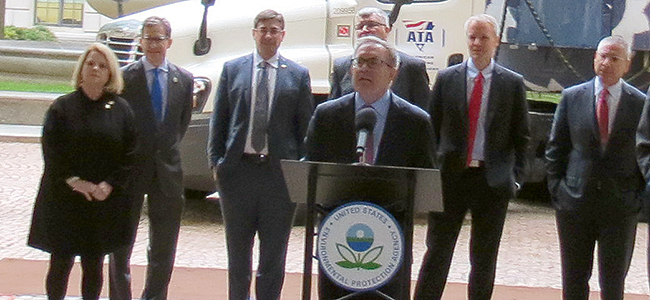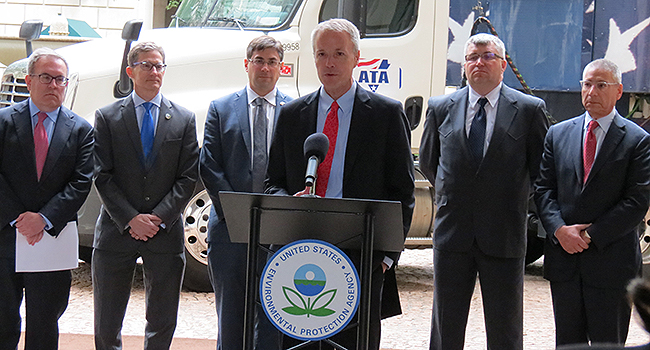Senior Reporter
EPA Plans to Review Nitrogen Oxide Emissions Standard for Heavy Trucks

WASHINGTON — U.S. Environmental Protection Agency officials announced Nov. 13 they have begun an environmental review to reduce nitrogen oxide emissions from heavy-duty truck engines.
Top agency officials labeled the review effort their “Cleaner Trucks Initiative,” but offered little detail about their plans or how long it will take to update the NOx standard.
“This initiative will help modernize heavy-duty truck engines, improving their efficiency and providing cleaner air for all Americans,” EPA acting Administrator Andrew Wheeler said. “This rulemaking will establish updated standards to address nitrogen oxide emissions for heavy-duty trucks. We will do this in a manner that improves air quality and protects public health without jeopardizing historic economic growth we’re achieving under President Trump.”
Since 2000, NOx emissions in the United States have been reduced by 52%, Wheeler said.

EPA acting Administrator Andrew Wheeler by Eric Miller/Transport Topics
“However, it is estimated that heavy-duty trucks will be responsible for one-third of NOx emissions from transportation by 2025. And it’s been nearly 20 years since EPA last set emissions standards for heavy-duty trucks,” Wheeler added.
Wheeler said part of the initiative will be to “cut unnecessary red tape while simplifying certification and compliance requirements for heavy-duty trucks.”
“For the past two decades, additional regulatory requirements have been added to on-highway heavy-duty vehicles in a piecemeal fashion,” he said. “This has resulted in some overly complex and costly requirements that do little to actually improve the environment.”
The areas of deregulatory focus will include onboard diagnostic requirements to ensure they focus on the functionality of key industry control system components, cost-effective means of assuring real-world compliance by using modern and advanced technology, the deterioration factor testing process, and concerns regarding annual recertification of engine families in which the underlying technologies have not changed from one model year to the next, Wheeler said.
EPA will be challenged to catch up with NOx reduction efforts by the California Air Resources Board, which is moving toward reducing its standard from EPA’s current NOx ceiling of 0.2 gram per brake horsepower-hour to 0.02 gram per brake horsepower-hour, a 90% reduction standard compared to EPA’s standard.

Bill Wehrum, assistant EPA administrator for air and radiation, said agency officials would work with the California Air Resources Board in updating the NOx requirements, but in the end the two agencies may not agree on everything.
Added Wheeler, “California has already done work on a low-NOx standard, and EPA’s effort will help provide a common sense, 50-state approach.”
Despite Wheeler’s optimism that EPA can come to a joint solution with CARB, there were no CARB representatives present at the news conference.
Wehrum cautioned the review is in its infancy.
“I’ll emphasize we are at the very beginning of a rulemaking and have a lot of work to do just to get to the proposed rule point, and even more work before we get to a final rule stage,” Wehrum said. “The reality is, we have a lot to figure out.”
Glen Kedzie, ATA’s vice president for environmental affairs, said the effort to reduce NOx emissions may involve a multitude of approaches in combination to achieve environmental success under the rule.
“There may not be just one given solution to satisfy EPA and California together,” Kedzie added.
A number of groups — including American Trucking Associations, the Owner-Operator Independent Drivers Association, and Truck and Engine Manufacturers Association — endorsed the effort.

ATA's Bill Sullivan speaks at EPA press conference Nov. 13. (Eric Miller/Transport Topics)
“We appreciate what the administrator and agency are doing, and very much that they’re working with business,” said Bill Sullivan, ATA’s executive vice president for advocacy. “It is good business to produce and to own and to drive cleaner, more fuel-efficient trucks. We operate in interstate commerce across all 50 states, so we need to have a harmonized federal standard, so we appreciate what the administrator is doing in bringing the people all together.”
“We appreciate the EPA for inviting OOIDA to participate in the roundtable to discuss the changes of the NOx standard for heavy trucks,” said Lewie Pugh, executive vice president of OOIDA. “But with technology use in heavy-duty trucks, we need to accomplish this to make sure that this is both affordable and reliable for the small business trucker.”
“Just over the last 20 years we’ve reduced NOx emissions by over 90%, particulate emissions by 98%,” said Jed Mandel, president of EMA. “Reflecting on the progress we’ve made to date is instructive, as we think about the keys to the success, keys which need to be carried forward. We ask the agency to follow the same roadmap of the past successes.”




